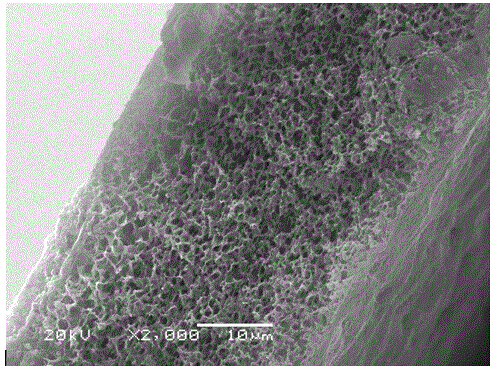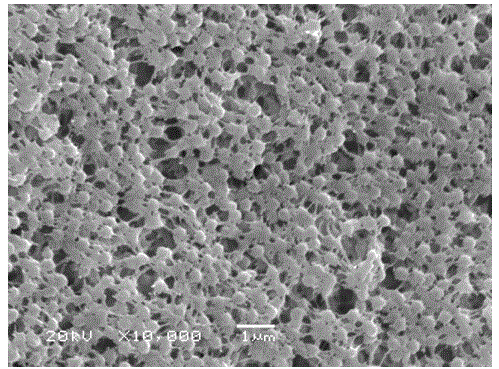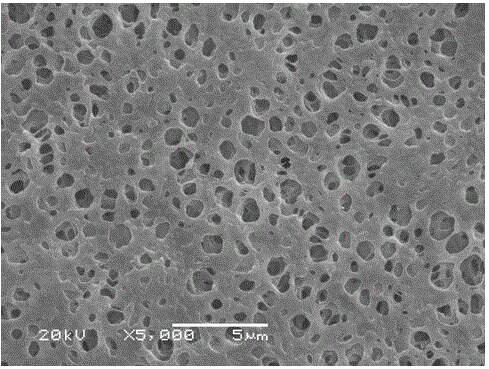Preparation method of high-flux PVDF (polyvinylidene fluoride) porous membrane
A porous membrane and high-flux technology, applied in chemical instruments and methods, membrane technology, semi-permeable membrane separation, etc., can solve the problems of restricting the application of membrane separation, low flux of polyvinylidene fluoride membrane, etc., to improve water flow amount, the effect of improving hydrophilicity
- Summary
- Abstract
- Description
- Claims
- Application Information
AI Technical Summary
Problems solved by technology
Method used
Image
Examples
Embodiment 1
[0023] Example 1: Put 8g polyvinyl alcohol, 8g polyvinylidene fluoride, 3g polyvinylpyrrolidone, 1g sodium nitrate, 1g deionized water, 38g dimethylacetamide, 40g dimethylformamide and 1g graphene powder in a cone Mix well in the flask, aging at 70°C for 48h, stirring at 70°C for 36h, and standing at room temperature for 48h to defoam to obtain a casting solution. Pour the casting liquid on the glass plate and scrape it to form a film. After the wet film was pre-evaporated in the air for 5 seconds, it was quickly placed in the coagulation bath for 1 min to initially replace the solvent. The coagulation bath was a deionized aqueous solution containing 20% dimethylacetamide. The membrane after preliminary replacement was soaked in deionized water for 7 days to form a preliminary membrane. The pre-formed film was heated and activated in deionized water at 40°C for 6 hours, then soaked in absolute ethanol for 12 hours, and then taken out, soaked in n-butanol for 12 hours, and dr...
Embodiment 2
[0024] Example 2: Mix 0.5g polymethyl methacrylate, 10g polyvinylidene fluoride, 1g lithium chloride, 0.5g deionized water, 88g dimethyl sulfoxide and 0.01g graphene powder in an Erlenmeyer flask. , Curing at 70 ℃ for 18h, stirring at 70 ℃ for 24h, and standing at room temperature for 24h to defoam to obtain a casting liquid. Pour the casting liquid on the glass plate and scrape it to form a film. After the wet film was pre-evaporated in the air for 10 minutes, it was quickly placed in a coagulation bath for 30 minutes to initially replace the solvent. The coagulation bath was a deionized aqueous solution containing 30% dimethyl sulfoxide and 20% dimethyl acetamide. The membrane after preliminary replacement is soaked in deionized water for 10 days to form a preliminary membrane. The pre-formed film was heated and activated in deionized water at 90°C for 0.5h, then soaked in absolute ethanol for 24h, and then taken out and soaked in n-butanol for 24h, and dried in the air. Th...
Embodiment 3
[0025] Example 3: Put 5g polyethersulfone, 10g polyvinylidene fluoride, 1.5g polyethylene glycol, 1g polyethersulfone, 0.01g deionized water, 82g dimethylformamide and 0.5g graphene powder in an Erlenmeyer flask Mix well, mature at 70°C for 8h, stir at 70°C for 24h, and stand at room temperature for 24h to defoam to obtain a casting solution. Pour the casting liquid on the glass plate and scrape it to form a film. After the wet film was pre-evaporated in the air for 30 seconds, it was quickly placed in a coagulation bath for 7 minutes to initially replace the solvent. The coagulation bath was a deionized aqueous solution containing 30% dimethylformamide. The membrane after preliminary replacement was soaked in deionized water for 7 days to form a preliminary membrane. The pre-formed film was heated and activated in deionized water at 30°C for 8 hours, and then soaked in absolute ethanol for 24 hours, then taken out and soaked in n-butanol for 12 hours, and dried in the air. T...
PUM
| Property | Measurement | Unit |
|---|---|---|
| tensile strength | aaaaa | aaaaa |
| contact angle | aaaaa | aaaaa |
| tensile strength | aaaaa | aaaaa |
Abstract
Description
Claims
Application Information
 Login to View More
Login to View More - R&D
- Intellectual Property
- Life Sciences
- Materials
- Tech Scout
- Unparalleled Data Quality
- Higher Quality Content
- 60% Fewer Hallucinations
Browse by: Latest US Patents, China's latest patents, Technical Efficacy Thesaurus, Application Domain, Technology Topic, Popular Technical Reports.
© 2025 PatSnap. All rights reserved.Legal|Privacy policy|Modern Slavery Act Transparency Statement|Sitemap|About US| Contact US: help@patsnap.com



